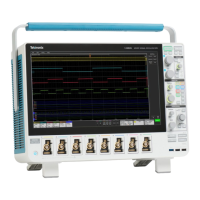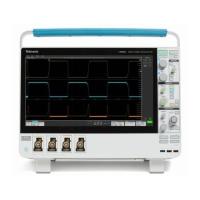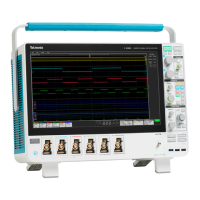Communication trigger. Communication trigger is not available on MSO/DPO5000B Series instruments.
Available with Mask Testing, this trigger is designed to work with communication masks and standards. Mask testing
automatically uses Communication triggers.
NOTE. You must install the Serial mask testing optionon some instruments before you can access the Comm triggers.
Video trigger. Video trigger is available on DPO7000C and MSO/DPO5000B Series instruments.
These are used to trigger the instrument on specified fields or lines of a video signal. You can use one of several preset video
signal formats or set a custom format.
Serial trigger. Serial trigger is not available on MSO/DPO5000B Series instruments.
Serial triggering allows you to define a 64-bit pattern and trigger on it. The serial pattern can be set in radices of binary or hex.
Serial triggering also offers Recovered Clock as the clock source in addition to Ch1 – Ch4. Use serial triggering in conjunction
with mask testing to trigger the instrument on communications codes and standards. The communication codes and standards
work together to define the parameters for the trigger event.
What do you want to do next?
Learn about trigger sources.
Learn about trigger modes.
Trigger modes
The trigger mode determines how the instrument behaves in the absence of a trigger event:
■
Normal trigger mode enables the instrument to acquire a waveform only when it is triggered. If no trigger occurs, the
instrument does not acquire a waveform, and the last waveform record acquired remains "frozen" on the display. If no last
waveform exists, no waveform is displayed.
■
Auto trigger mode enables the instrument to acquire a waveform even if a trigger does not occur. Auto mode uses a timer
that starts after a trigger event occurs. If another trigger event is not detected before the time out, the instrument forces a
trigger. The length of time it waits for a trigger event depends on the time base setting.
Auto mode, when forcing triggers in the absence of valid triggering events, does not synchronize the waveform on the display. In
other words, successive acquisitions are not triggered at the same point on the waveform; therefore, the waveform will appear to
roll across the screen. If valid triggers occur, the display will become stable.
What do you want to do next?
Learn about trigger sources.
Learn about trigger types.
Trigger holdoff
Trigger holdoff can help stabilize triggering. When the instrument recognizes a trigger event, it disables the trigger system until
acquisition is complete. In addition, the trigger system remains disabled during the holdoff period that follows each acquisition.
Adjust holdoff to obtain stable triggering when the instrument is triggering on undesired trigger events.
A digital pulse train is a good example of a complex waveform. Each pulse looks like any other, so many possible trigger points
exist. Not all of these will result in the same display. The holdoff period allows the instrument to trigger on the correct edge,
resulting in a stable display.
Oscilloscope reference
666 DPO70000SX, MSO/DPO70000DX, MSO/DPO70000C, DPO7000C, and MSO/DPO5000B Series

